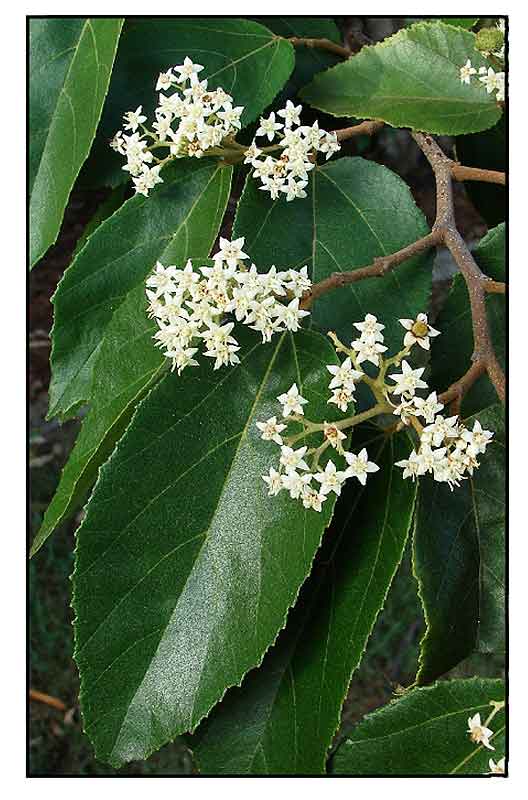 Gen info Gen info
- Brown kurrajong was first formally described by Carl Linnaeus in 1759 when it was given the name Muntingia bartramia in Amoenitates Academicae. In 1917, Elmer Drew Merrill changed it to Commersonia bartramia in his book, An Interpretation of Rumphius's Herbarium Amboinense. (3)
- Etymoloogy: The genus Commersonia was named after French naturalist Philibert Commerson, 1728-1773, a member of the Bougainville expedition. The species epithet bartramia was named after J. & W Bartam.
Botany
Commersonia bartramia is a densely stellate-pubescent small tree, up to 15 m tall; trunk 15-25 cm in diameter; twigs often flexuous. Leaves arranged spirally, simple; stipule palmatilobed, caducous; petiole 0.5-1.5 cm long; blade herbaceous, suborbicular-ovate-oblong, 6-30 cm x 2.5-25 cm, base cordate to subtruncate, often oblique, margin serrate-dentate or lobed, apex acutely acuminate, palmately veined, sparsely stellate-pubescent to nearly glabrous above. Inflorescence an axillary, leaf-opposed or terminal corymbose cyme; flowers bisexual, 5-merous; sepals connate, ovate, 3-3.5 mm long, white, often inrolled; petals white, with widened concave base (cap); receptacle flat; staminal tube short, not adnate to the petal, crowned by 5 subsessile or stalked stamens (opposite the petals) alternating with 5 petaline staminodes; staminodes triangular-lanceolate, at first coherent, concealing the ovary, afterwards apically recurved, acute, white; filaments distinct, anthers subglobose, accumbent against base of petals, 2- celled; ovary 5-celled, ovules 2-6 in each cell; styles 5, short. Fruit a globose, woody capsule, 2 - 2.5 cm in diameter (including stellate-hairy bristles), dehiscent loculicidally, 5-valved, with 1-2 seeds in each cell. (1)
 Commersonia bartramis is a small tree or shrub up to 20 m tall, twigs with numerous white lenticels. Leaves ovate to broad-ovate, lamina mostly 6–15 cm long, 4–10 cm wide, ± entire to toothed with 4–6 teeth per cm, lower surface tomentose, yellowish to greenish grey; petiole usually 10–20 mm long. Staminodes pubescent, central lobe tomentose, shorter than petals, lateral lobes small, filiform, tomentose, attached to stamen filaments. Capsule 10–20 mm diam., bristles stellate-pubescent, 3–8 mm long. (2) Commersonia bartramis is a small tree or shrub up to 20 m tall, twigs with numerous white lenticels. Leaves ovate to broad-ovate, lamina mostly 6–15 cm long, 4–10 cm wide, ± entire to toothed with 4–6 teeth per cm, lower surface tomentose, yellowish to greenish grey; petiole usually 10–20 mm long. Staminodes pubescent, central lobe tomentose, shorter than petals, lateral lobes small, filiform, tomentose, attached to stamen filaments. Capsule 10–20 mm diam., bristles stellate-pubescent, 3–8 mm long. (2)
Distribution
- Native to the Philippines.
- In grassands, brushwood, thickets, and secondary forests, up to 1250 m altitude.
- Also native to the Bismark Archipelago, Borneo, Cambodia, China, Fiji, Hainan, Jawa, Laos, Malaya, Maluku, Myanmar, New Caledonia, New Guinea, New South Wales, Queensland, Samoa, Santa Cruz Is., Sumatera, Thailand, Vietnam, Wallis-Futima Is.
(3)
- Planted as ornamental in Australia.
Constituents
- Study of dried, ground fruits macerated in methanol for phytoconstituents yielded two coumarins, scoparone (1), 6,8-dimethoxycoumarin (2), and three flavonoids, kaempferol (3), chalcone (4), apigenin 5-O-glucoside (5). (7)
Properties
- Studies have suggested cytotoxic, anticancer properties.
Parts used
Bark. leaves.
Uses
Edibility
- No information found on edibility of fruit.
Folkloric
- In Fuji, Japan, used to treat coughs and colds, rheumatism, kidney troubles and dysentery. (7)
- In north Sumatra, Indonesia, bark used for treatment of sprue.
(8)
- The Batak Toba tribe of North Sumatra, Indonesia, use leaves for treatment of malaria and abdominal pain.
Others
- Fiber / Crafts: In the Philippines and Indonesia, the bast is made into general purpose ropes. In Sumatra, it is woven into mats. In the time of Dutch East Indies Company, fuses were spun from the bast. In New Britain, Papua New Guinea, the bast fiber is used as string for women's girdles. (1) Australian aborigenes use the cordage for making fish and kangaroo nets.
- Wood: Light in weight, soft, and close-grained. Used for light construction, fishing floats, etc.
- Fuel: Makes a good source of firewood. In the Bismark Archipelago, used for making headbands. (1)
Studies
• Anticancer: Study in a mouse model evaluated the cytotoxicity and chemical sensitization of Commersonia bartramia (CB) and Dendropanax morbifera (DM) extracts on gynecologic and colon cancers and their potential for immunotherapy. Reverse transcription-polymerase chain reaction was conducted to determine alternations in drug-resistant genes. The extracts from DM and CB showed specific cytotoxicity to malignant cell lines. CB improved sensitization to endometrial cancer. Results suggest both extracts could be novel agents for immunotherapy and chemical sensitization in gynecologic and colon cancers. (5)
• Copper Nanoparticles: Study reports on the eco-friendly synthesis of Cu nanoparticles using the plant extract as green reducing agent. Cu/Al2O3NPs can be recovered and reused in a reduction reaction several times without loss of catalytic activity. (6)
• Cytotoxicity: In a study of crude alcoholic extracts of ten alkaloid-bearing plants for biological activity, Commersonia bartramia displayed cytotoxicity in brine shrimp lethality bioassay as well as inhibition of crown gall tumor growth. (9)
Availability
Wild-crafted.
|

![]()





